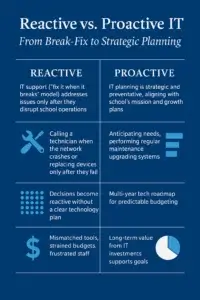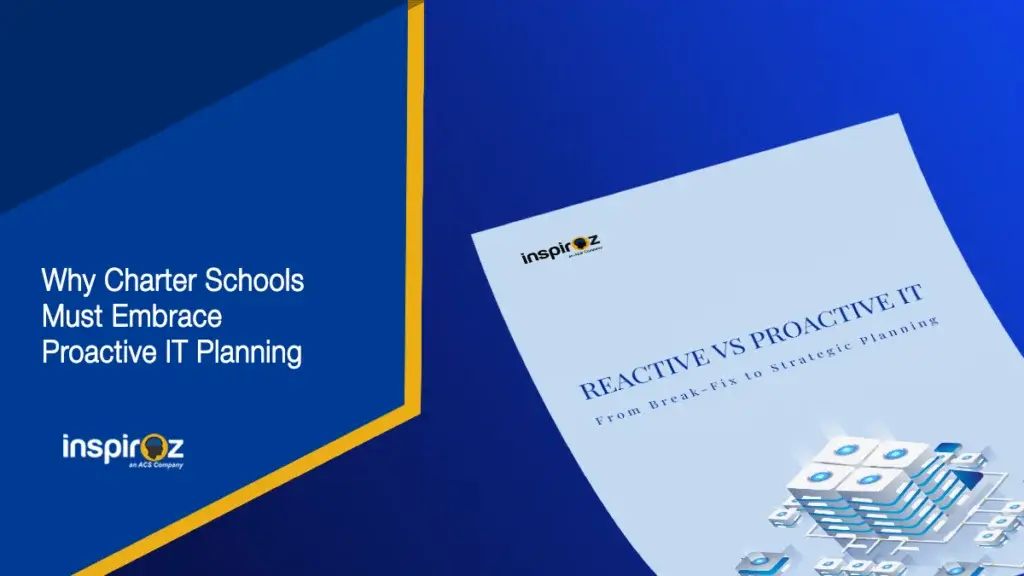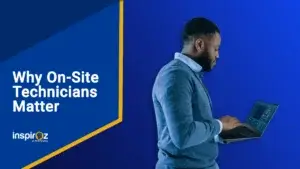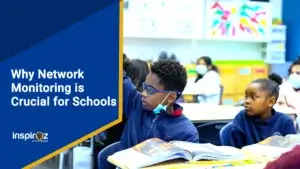Technology has become mission-critical for charter schools, supporting everything from digital curriculum delivery to administrative operations. Yet too often, school IT is handled in a reactive way – meaning tech support is only called when something breaks.
This “break-fix” approach might solve the immediate issue, but it leaves schools perpetually putting out fires. What charter schools truly need is proactive IT planning: a forward-looking strategy to anticipate needs, prevent problems, and align technology with educational goals.
Reactive vs. Proactive IT: From Break-Fix to Strategic Planning
Reactive IT support (the “fix it when it breaks” model) addresses issues only after they disrupt school operations. 
For example, a reactive approach might involve calling a technician when the network crashes or replacing devices only after they fail. This mode often leads to scrambling during emergencies and implementing ad-hoc solutions that may not fit into a long-term vision.
As one guide notes, without a clear technology plan, decisions become reactive – leading to mismatched tools, strained budgets, and frustrated staff. In other words, if you don’t plan ahead, you risk accumulating a patchwork of incompatible software and hardware, unexpected costs, and a lot of headaches for teachers and administrators.
In contrast, proactive IT planning is strategic and preventative. It means charting out a multi-year technology roadmap that aligns with your school’s mission and growth plans. Instead of just reacting to issues, a proactive strategy involves anticipating needs (like increasing bandwidth before rolling out a 1:1 device program), performing regular maintenance, and upgrading systems before they become obsolete.
According to a charter school technology planning guide, a well-crafted multi-year tech plan offers predictable budgeting over multiple fiscal years, future-proofing against fast-moving tech trends, and better support and training for staff. In short, proactive planning ensures each IT investment brings long-term value and that technology actively supports your academic and operational goals.
Challenges in Charter School IT Management
Charter schools operate in a unique context that can make IT management especially challenging. It’s important to understand these pain points, because many of them are exactly what push schools into a reactive stance:
- Limited IT Staff and Budget: Most charter schools have lean staffing and tight budgets. Hiring a full in-house IT department is often impractical. As a result, schools might rely on a single tech-savvy staff member or an external contractor who is only called in for emergencies. This setup makes it hard to do long-term planning. Indeed, many charters operate with limited budgets that make it challenging to resource a full-scale IT department. Lacking dedicated expertise day-to-day means critical tasks like system updates or strategic planning can fall by the wayside until a crisis hits.
- Rapid Growth and Changing Needs: Charter schools are frequently evolving – whether adding new grade levels, expanding to additional campuses, or adopting innovative teaching models. This growth spurt is great for education, but it strains IT systems. Without proactive planning, a school that doubles its student population might find its Wi-Fi hopelessly overloaded or its server storage maxed out.
Technology needs can quickly outpace the ad-hoc solutions put in place. For example, if a school doesn’t plan for scaling, adding a new computer lab or implementing an online testing platform can lead to network slowdowns or crashes at critical moments.
- Inconsistent Infrastructure and Downtime: Many charters struggle with aging or piecemeal infrastructure – spotty Wi-Fi, outdated routers, or unreliable devices. When the network is consistently going down (or slow), it disrupts learning, frustrates teachers, and embarrasses school leaders.
In a reactive model, each outage is handled as a separate incident; but without addressing root causes, the outages keep happening. This inconsistent technology environment makes it hard for teachers to fully integrate digital tools in the classroom (since they can’t trust the systems to be up), and it diverts administrative time to constantly troubleshooting tech issues.
- Cybersecurity Threats and Data Privacy Concerns: Schools have become prime targets for cyber attacks, but charter schools often have weaker defenses compared to larger districts. Limited IT resources mean things like firewall tuning, security updates, and user training might not happen regularly.
Unfortunately, cyber threats are very real for K-12 education. Charter schools house significant amounts of sensitive data – student records, payroll, financial information – that hackers would like to steal and exploit. A school that takes a reactive approach to cybersecurity might only tighten its security after a phishing scam or ransomware incident occurs.
The fallout from such incidents can be severe: one school’s state assessments were disrupted when ransomware shut down all their computers, and it took weeks to rebuild the network after they refused to pay the hackers. This kind of disruption underscores how high the stakes are for not being prepared. Moreover, failure to protect data can lead to violations of privacy laws (like FERPA or COPPA) and cause irreversible damage to a school’s reputation.
- Fragmented EdTech and Data Systems: Charter schools often enjoy the freedom to choose their own curriculum tools, learning apps, student information systems (SIS), etc. Without coordination, this can lead to a jumble of platforms that don’t talk to each other.
Administrators might find that they can’t leverage the full range of their systems – for instance, student data living in separate silos because the SIS isn’t integrated with the learning management system (LMS). Teachers might be juggling multiple logins and manual data entry, increasing the chances of errors and burnout. In a reactive scenario, schools add new apps as needed but never get around to developing an integration plan or training users across the board.
These challenges illustrate why just “fixing what breaks” isn’t enough. Charter school leaders are juggling a lot: expanding programs, tight finances, compliance requirements, and high parent expectations. A reactive IT posture might seem to save money upfront, but it often exacerbates these challenges – leading to more costly emergencies, inefficiencies, and vulnerabilities down the line.
Benefits of Proactive IT Planning for Charter Schools
Moving to a proactive IT strategy directly addresses the challenges above. Instead of technology being a constant source of stress, it becomes a well-managed asset that propels your school forward. Here are some key benefits of proactive IT planning, and why they matter for charter schools:
1. Predictable Budgeting and Cost Control
One of the biggest advantages of planning your IT initiatives is financial stability. Charter schools must be very prudent with funds, and unexpected tech emergencies can wreak havoc on a budget. Proactive planning puts you back in control of IT costs by shifting from unpredictable break-fix expenses to planned investments. For example, rather than suddenly spending thousands to replace failing hardware during the school year, you can budget for phased equipment upgrades over 3-5 years.
Many schools find value in partnering with managed IT services as part of this strategy. Managed services often operate on a flat monthly fee or subscription, turning large capital expenses into predictable operational costs. This means fewer surprise bills. As one resource highlights, cloud-managed services convert big upfront costs (servers, emergency repairs) into clear monthly budgeting and fewer emergency IT expenses. In practice, this allows charter schools to allocate more funds toward educational programs instead of rainy-day funds for IT crises.
Furthermore, with a proactive approach you can conduct cost-benefit analyses for new technology initiatives in advance. Want to implement a 1:1 student device program or adopt a new e-learning platform? In a proactive plan, you’d forecast the costs, explore bulk purchasing or grants, and schedule the rollout at a fiscally sound time. This level of planning ensures that every dollar spent on tech brings long-term value to your classrooms, students, and staff, rather than just patching holes. Administrators can go into each budget cycle with a clear view of upcoming IT needs, making it far easier to justify expenses to boards or authorizers because there’s a documented strategy behind each line item.
2. Reduced Downtime and Disruptions
Ask any principal or teacher who’s been through it – there are few things more disruptive than a technology meltdown in the middle of a school day. Whether it’s the internet going down during state testing or the smart boards all refusing to connect on the morning of an important lesson, downtime can directly impact student learning and staff productivity. Proactive IT planning aims to minimize these disruptions so that technology is consistently reliable.
How does it achieve this? Primarily through regular maintenance and preventative measures. Instead of waiting until a server fails, proactive maintenance schedules ensure that servers are patched, backed up, and replaced before end-of-life. Instead of finding out the hard way that your Wi-Fi can’t handle 200 devices streaming video, proactive capacity planning would lead you to upgrade bandwidth or access points beforehand. Managed IT providers excel at this kind of 24/7 monitoring and upkeep – they watch your network for warning signs and address issues before they escalate into outages. For instance, continuous network monitoring can detect a failing network switch and allow it to be replaced after school hours, averting an unplanned outage the next day. As the managed services team at Inspiroz notes, their proactive approach includes addressing potential issues quickly, before they escalate, to ensure consistent uptime for critical systems like SIS and LMS platforms.
The results of reduced downtime are significant. Teachers and students can trust that the digital tools they plan to use will be available, which encourages more meaningful integration of technology into learning. Administrators aren’t taken away from their day-to-day focus to deal with tech emergencies. Over time, you build a reputation (with parents, inspectors, etc.) that your school runs smoothly on the tech front.
There’s a powerful case study illustrating this: one charter school that had been facing frequent system outages and disruptions switched to a proactive managed IT model. After implementing 24/7 monitoring, timely hardware upgrades, and other improvements, the school achieved 99.9% uptime and significantly streamlined its operations.
In other words, virtually no class time was lost due to IT issues, and the staff could refocus on teaching rather than troubleshooting. The peace of mind that comes with reliable systems is hard to overstate – it means your teachers can carry on with their lesson plans and online assessments without anxiety about whether the network or devices will fail.
3. Improved Data Security and Compliance
Data security is a huge concern in education today. A reactive approach to IT often means security gets attention only after an incident (for example, scrambling to update systems after a virus has hit or after someone fell for a phishing email). Proactive IT planning, on the other hand, treats cybersecurity as a continuous priority. This includes putting strong defenses and policies in place before disaster strikes, and continuously updating them as new threats emerge.
For charter schools, which might not have dedicated cybersecurity staff, a proactive strategy could involve working with specialists or managed security services. These experts will implement measures like advanced firewalls, intrusion detection systems, regular security audits, and staff training on security best practices. The goal is to identify and address potential risks proactively, safeguarding your school’s data and reputation.
For instance, managed IT security services typically include features such as: real-time threat monitoring, routine software patching to fix vulnerabilities, encrypted backups, and tested disaster recovery plans. If an issue is detected – say, a malware attempt – automated systems can alert IT staff and isolate the threat immediately, often before it spreads. Early detection and response can make the difference between a minor contained incident and a full-blown breach.
The benefits of this proactive stance on security are both practical and reputational. Practically, you greatly reduce the risk of having to shut down school for days or weeks due to a cyberattack (recall the New Jersey school that lost weeks recovering from ransomware – an ordeal no one wants to repeat).
Instead, proactive measures minimize these risks and provide peace of mind, so that even if hackers attempt an attack, your defenses are ready. On the compliance side, charter schools must adhere to laws like FERPA (for student records privacy) and HIPAA (if handling health data), as well as state data protection laws. Proactive IT planning ensures compliance is built into your systems – for example, making sure all sensitive data is access-controlled and encrypted, and that you have proper data retention and deletion policies. Managed service providers often help ensure schools meet education-related data privacy requirements, sparing your team from legal pitfalls that can occur if security is treated casually.
Beyond preventing bad outcomes, strong security enables positive uses of technology. When teachers and families trust that digital tools are safe and student information is protected, they are more likely to embrace online systems for things like learning management, parent communication, and cloud-based learning resources. In essence, proactive security not only protects your school community but also creates an environment where technology can be used to its fullest potential without fear.
4. Smoother EdTech Integration and Innovation
Charter schools are known for innovation and often pilot new educational technologies – from adaptive learning software to digital assessment tools. However, integrating new EdTech into the classroom or school operations can be rocky without proper planning. How many times have we seen well-intentioned tech initiatives falter because teachers weren’t trained, the infrastructure couldn’t support the tool, or it just didn’t align with the school’s needs?
Proactive IT planning makes EdTech adoption smooth and effective. It starts with aligning technology choices to educational goals. In a proactive planning process, school leaders ask: What are our academic objectives, and what technology will best support them? By doing this, you avoid buying gadgets or software just because they’re trendy; instead, you invest in tools that truly enhance learning or efficiency.
Moreover, with a plan in place, technology decisions are made strategically rather than ad-hoc, preventing the problem of mismatched tools that don’t work well together. For example, if improving data-driven instruction is a goal, the plan might include selecting an assessment platform that integrates with your existing gradebook system, and scheduling teacher training on that platform before it launches.
Another aspect is timing and support for new initiatives. Proactive IT means coordinating the rollout of new technology – upgrading the network if needed, setting up user accounts, piloting with a small group first, and ensuring technical support is ready. Perhaps you want to implement a new Student Information System (SIS) or Learning Management System (LMS).
A proactive approach would involve mapping out the transition (including data migration from the old system), providing training sessions for staff, and maybe running the new system in parallel with the old for a trial period. This level of preparation is far less stressful than the reactive scenario of scrambling when the old system fails unexpectedly and you’re forced into a hasty adoption of something new.
In fact, guidance from IT consultants suggests that when working with an outsourced IT partner, the first step should be to assess your current state and create a 3-5 year technology plan that accounts for major projects like new system implementations or 1:1 device programs. By planning these changes well in advance, you ensure the smoothest possible transition when the time comes.
Proactive planning also entails providing better support and training for teachers and staff around new technologies. This might include ongoing professional development sessions, how-to guides, and having IT support (or tech-savvy teacher leaders) available to troubleshoot in the early days of a new tool. When staff feel supported and competent with technology, they are more likely to use it fully, which means the school gets the maximum benefit from its investment.
Compare that to a reactive environment where a new app might be introduced without training – teachers quickly become frustrated and either bombard the minimal IT support with help requests or abandon the tool altogether. Proactive planning avoids that waste by ensuring each new technology is seamlessly integrated into the school’s ecosystem.
As one service provider focused on charter schools emphasizes, expert managed IT services can help “seamlessly integrate the latest educational technologies” into your school while ensuring everything works in harmony. This includes making sure your infrastructure (Wi-Fi, devices, etc.) is ready for the new tech and that any required integrations (say between your SIS and a new analytics platform) are configured properly.
Finally, with proactive planning, charter schools can stay ahead of the curve in innovation. Instead of lagging and playing catch-up with tech, you’ll have a roadmap that might include exploring emerging technologies (like AI learning tools or improved data analytics) at the appropriate time. Your school becomes future-ready. Proactive IT isn’t about technology for technology’s sake – it’s about enabling your educators and students to teach and learn with the best tools, with as few hurdles as possible. When done right, it frees up your educators to focus on student outcomes while the tech “just works” in the background.
Putting Proactive IT Planning into Action
Understanding the benefits is one thing – implementing proactive IT planning is another. How can charter school administrators transition from a reactive approach to a proactive one? Here are a few actionable strategies:
- Develop a Multi-Year Technology Plan: If your school doesn’t already have a written technology plan, consider making this a top priority. Start by assessing your current technology landscape (inventory all devices, infrastructure, software, and support processes) and identify pain points. Then, define your school’s educational and operational goals for the coming years.
The plan should bridge these two – outlining what technology initiatives or upgrades are needed to support those goals. For example, if in three years you aim to have a STEM lab or fully online assessments, what does your network or hardware procurement need to look like?
A 3-year tech plan can align tech initiatives with your school’s mission, budget cycles, and growth projections. Make sure to involve key stakeholders (administrators, teachers, even students) in the planning process for buy-in and comprehensive insight.
- Leverage Expertise – Consider Managed IT or vCIO Services: You don’t have to do this alone. Many charter schools are turning to managed IT service providers or virtual CIO services to get the benefits of proactive IT without hiring a large in-house team. A good MSP (Managed Service Provider) will not only fix things, but also become a partner in planning your tech future. They often begin engagements by stabilizing your environment and then helping craft a roadmap. For instance, Inspiroz provides technology consulting to assist with long-term planning and budgeting, helping schools develop tech roadmaps that ensure investments are strategic, cost-effective, and future-proof.
Similarly, a vCIO (virtual Chief Information Officer) service can act as an advisor, sitting in your planning meetings and translating educational goals into IT strategy. The key is to choose a partner who understands the education sector’s unique needs. By outsourcing certain IT functions to experts who deliver proactive maintenance and dedicated support focused on schools, charter leaders can gain peace of mind that someone is always thinking a few steps ahead on the technology front. This partnership can also include robust help desk support for day-to-day issues – with a 24/7 support team on call, small problems get resolved quickly before they derail classes.
- Regularly Review and Update Your IT Strategy: Proactive planning isn’t a one-and-done document that sits on a shelf. Schedule regular check-ins (e.g., quarterly) to review your IT strategy’s progress. This could involve reviewing reports of network performance, support ticket trends, cybersecurity audits, etc., to identify where adjustments are needed. If you have an outsourced IT partner, hold them to this by having them report on key metrics and progress on projects. A blog on getting value from outsourced IT partners suggests setting clear goals and then scheduling monthly or quarterly meetings to go over progress and ensure everyone is on the same page. By keeping the communication open, you can adapt your plan as circumstances change (for example, pivoting to support a sudden move to hybrid learning, or accelerating a device refresh if you find more devices failing than anticipated).
- Invest in Professional Development and Cultivate a Tech-Positive Culture: Even the best-laid IT plans can stumble if the people in your school aren’t on board. Proactive IT management includes preparing your staff and students to use technology effectively and safely. Budget time and resources for training sessions when new systems are introduced (e.g., new SIS, new security protocols, etc.). Encourage teachers to share tech best practices with each other, perhaps through an internal tech committee or champions.
Also, proactively establish policies (like an acceptable use policy, data privacy policy) and educate everyone on them before issues arise. When technology is seen as an integral part of the school (and not some external burden), the whole community can help in identifying needs early and suggesting innovations. This culture shift means that instead of dreading technology changes, your staff might start proposing ideas for improvement – which is the epitome of being proactive.
By taking these steps, charter school administrators can gradually but surely move their schools away from the reactive break-fix cycle. The transition might require some upfront effort and investment, but the payoff is a school where technology boosts learning and operations every day, without constant surprises.
Charter schools have too much at stake to let technology be an afterthought. A reactive approach to IT – just fixing problems as they come – may keep the lights on, but it won’t position your school for success. By contrast, proactive IT planning is about foresight and alignment: ensuring your technology environment is reliable, secure, and ready to support your educational mission both now and in the future. From stable budgets and minimal downtime to robust cybersecurity and seamless EdTech integration, the benefits of being proactive are compelling. They translate into real gains like more instructional time, protection of sensitive student data, and better outcomes on your digital initiatives.
For charter school leaders, the message is clear: don’t wait for the next tech crisis to act. Start laying out a strategic IT roadmap and seek out the resources or partners that can help execute it. Whether it’s through a multi-year technology plan developed in-house or with the guidance of a school-focused IT partner, what matters is adopting a mindset of preventive care for your technology.
Just as you wouldn’t run a school facility without regular maintenance, your IT infrastructure and digital tools also need consistent, planned care. With proactive planning in place, you can stop reacting to IT fires and instead direct your energy where it truly belongs – innovating and providing an exceptional educational experience for your students. After all, when technology runs smoothly in the background, your charter school can shine in the foreground.







